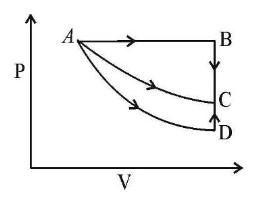Thermodynamics
Get insights from 326 questions on Thermodynamics, answered by students, alumni, and experts. You may also ask and answer any question you like about Thermodynamics
Follow Ask QuestionQuestions
Discussions
Active Users
Followers
New answer posted
2 months agoContributor-Level 10
q = 0, w = 0,
As volume changes, temperature must change to maintain constant internal energy.
New answer posted
2 months agoContributor-Level 10
P = (RT/M? )ρ ⇒ P/ρT = constant
⇒ (12)/ (4 * 10? ³ * 10? ) * 280 = 6 * 10? * T ⇒ T = 1400K
New answer posted
2 months agoContributor-Level 10
Vibrational energy of a non-rigid gas molecule is K? T so, total energy = (5/2)K? T + K? T = (7/2)K? T
∴ C? = (7/2)R
New answer posted
2 months agoContributor-Level 10
ΔG° = – 2.303RT log Kp = – 2.303* 2 * 300log10? ³
= – 2.303* 2 * 300 * (– 3) = 4145.4cal mol? ¹
New answer posted
2 months agoContributor-Level 10
ΔH_rxn = ΔH_f (N? O, g) + 3ΔH_f (CO? , g) – (2ΔH_f NO? , g) – 3ΔH_f (CO, g)
= 81 + 3* (– 393) – 2 * 34 – 3 (–110)
= 81 – 1179 – 68 + 330 = – 836 kJ
New answer posted
2 months agoContributor-Level 10
One mole of water is converted to vapour at its boiling point which is 100°C and at 1 atm. For this process ΔG = 0. As phase transformation of water is an equilibrium process and at equilibrium, free energy change is always zero.
New answer posted
2 months agoContributor-Level 10
2CO (g) + O? (g) → 2CO? (g)
Δn_g = 2 – (2 + 1) = -1
ΔH = ΔE + Δn_g RT or ΔH = ΔE – 1RT
i.e. ΔH < E
New answer posted
2 months agoContributor-Level 10
(Q? - Q? )/Q? = (T? - T? )/T? ; Q = (300/600) * 1600 = 800 J
work done = Q? - Q? = 1600 – 800 = 800J
Taking an Exam? Selecting a College?
Get authentic answers from experts, students and alumni that you won't find anywhere else
Sign Up on ShikshaOn Shiksha, get access to
- 65k Colleges
- 1.2k Exams
- 679k Reviews
- 1800k Answers

